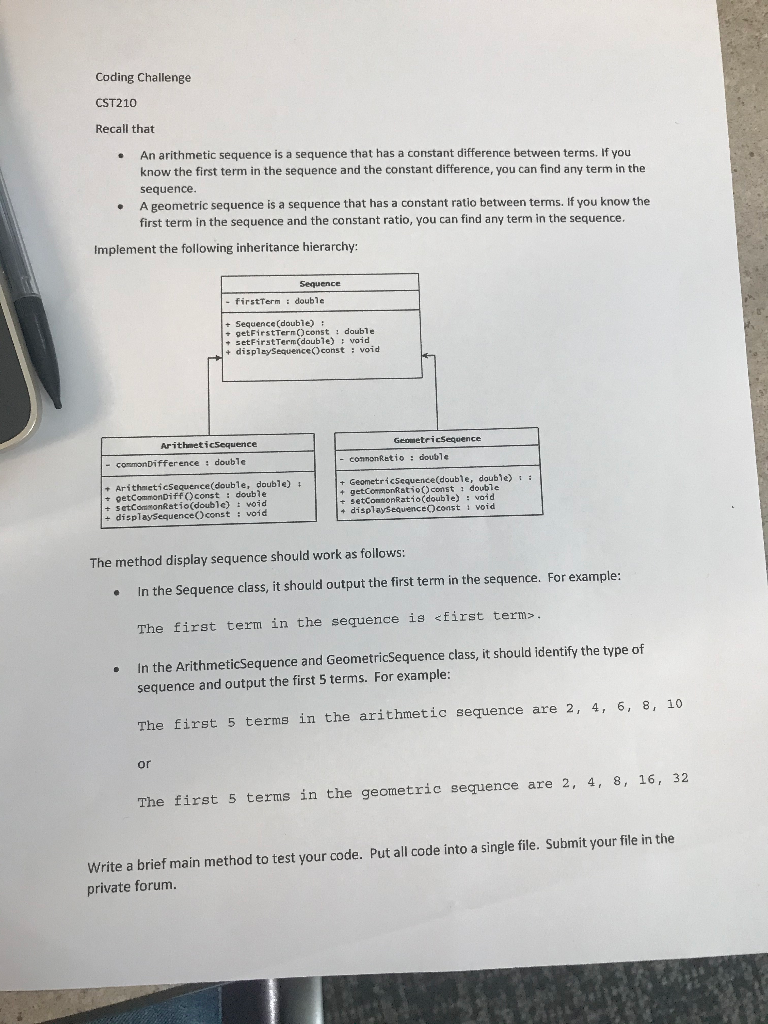 using c++
using c++
Coding Challenge CST210 Recall that An arithmetic sequence is a sequence that has a constant difference between terms. If you know the first term in the sequence and the constant difference, you can find any term in the sequence. A geometric sequence is a sequence that has a constant ratio between terms. If you know the first term in the sequence and the constant ratio, you can find any term in the sequence. Implement the following inheritance hierarchy: Sequence firstTerm: double + Sequence (double): + get FirstTern(const 1 double - setFirst Term(double) } void + display Sequence(const : void ArithmeticSequence - commonDifference : double Geometricsequence - common Ratio : double + ArithmeticSequence (double, double) + + getCommonDiffconst : double + setCommonRatio(double) : void + displaySequence const : void Geometricsequence(double, double) : : + getCommonRatio const i double + setCommonRatio (double) void + displaySequence const 1 void The method display sequence should work as follows: In the Sequence class, it should output the first term in the sequence. For example: The first term in the sequence is first term>, In the ArithmeticSequence and Geometric Sequence class, it should identify the type of sequence and output the first 5 terms. For example: The first 5 terms in the arithmetic sequence are 2, 4, 6, 8, 10 The first 5 terms in the geometric sequence are 2, 4, 8, 16, 32 Write a brief main method to test your code. Put all code into a single file. Submit your file in the private forum. Coding Challenge CST210 Recall that An arithmetic sequence is a sequence that has a constant difference between terms. If you know the first term in the sequence and the constant difference, you can find any term in the sequence. A geometric sequence is a sequence that has a constant ratio between terms. If you know the first term in the sequence and the constant ratio, you can find any term in the sequence. Implement the following inheritance hierarchy: Sequence firstTerm: double + Sequence (double): + get FirstTern(const 1 double - setFirst Term(double) } void + display Sequence(const : void ArithmeticSequence - commonDifference : double Geometricsequence - common Ratio : double + ArithmeticSequence (double, double) + + getCommonDiffconst : double + setCommonRatio(double) : void + displaySequence const : void Geometricsequence(double, double) : : + getCommonRatio const i double + setCommonRatio (double) void + displaySequence const 1 void The method display sequence should work as follows: In the Sequence class, it should output the first term in the sequence. For example: The first term in the sequence is first term>, In the ArithmeticSequence and Geometric Sequence class, it should identify the type of sequence and output the first 5 terms. For example: The first 5 terms in the arithmetic sequence are 2, 4, 6, 8, 10 The first 5 terms in the geometric sequence are 2, 4, 8, 16, 32 Write a brief main method to test your code. Put all code into a single file. Submit your file in the private forum
 using c++
using c++





